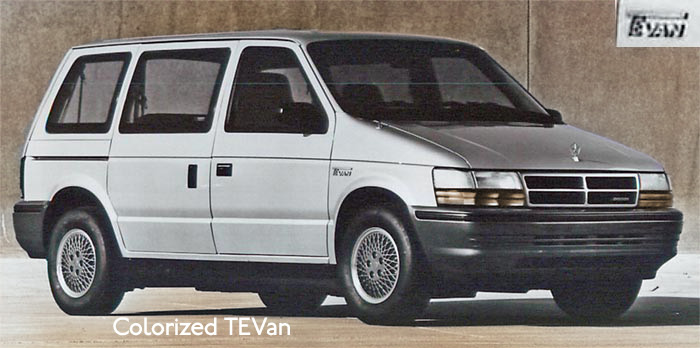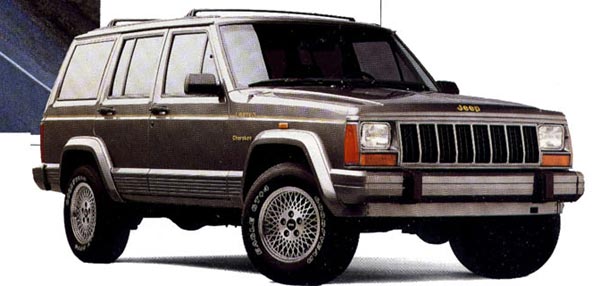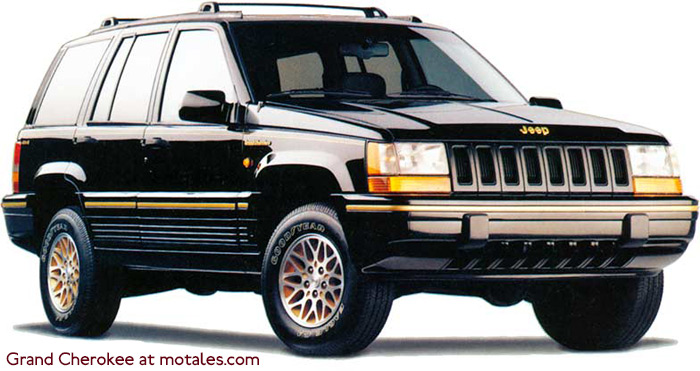Their annual report proudly declared that “1992 was the year of breaking away from the competition,” and it certainly was the start of something new. Until 1992, Chrysler needed high rebates to sell their cars, losing $795 million in 1991. In 1992, they showed a $723 million profit, and from 1992 to 1999 they would go from triumph to triumph.

The new Dodge Intrepid, Chrysler Concorde, and Eagle Vision resurrected full-sized cars; the Vision was Automobile’s Automobile of the Year, matching the Jeep Grand Cherokee’s Motor Trend Truck of the Year (it was the Grand’s first year, though it seems like it’s been around forever). The Viper was thrilling people with its raw torque.
US sales totals by marque for vans, SUVs, and trucks were:
| Dodge | Plymouth | Chrysler | Jeep Eagle |
|
|---|---|---|---|---|
| Cars | 259,926 | 164,448 | 148,010 | 45,028 |
| Minivans | 251,921 | 201,016 | 16,905 | 0 |
| Other | 294,860 | 0 | 0 | 268,724 |
| Total | 806,707 | 365,464 | 164,915 | 313,752 |
Chrysler sold a stunning 469,842 minivans, on two wheelbases, with various seat configurations, and a choice of three engines. They were the company’s best-selling category of vehicles. They even made electric versions for fleet use, the TEVans.

Dodge trucks had been fading for years, and in the mid-1980s, senior management had decided to phase them out. When Iacocca bought AMC in 1987, the executives changed their minds, but that wouldn’t change anything in 1992.
The best selling Dodge or Jeep truck at that time was the Dodge Dakota (132,067), designed largely by an outside company to copy the International Scout. It was followed closely by the Jeep Cherokee SUV, a hit for AMC and Chrysler alike. The Cherokee was one of the most capable 4x4s, but had quite docile manners, a powerful straight-six (or cheap four-cylinder), good space usage, and a pleasing design. It was light and the body was low to the ground, yet had the best ground clearance in its class—an excellent feat of engineering. There were few drawbacks; the Cherokee outclassed the (better-selling) Ford Explorer on-road and off-road.

The big Ram pickup sold a mere 80,098 pickups, including light and heavy duty, with both gasoline and Cummins diesel engines; it couldn’t have been profitable at those numbers, with all those variations. New multiple-point fuel injection in these pickups’ closely-related 3.9 and 5.2 liter engines may have helped with sales; the same fuel injected engines were sold on the Dakota and in the B-vans.
The Jeep Wrangler was still a niche vehicle, with just 49,724 sales—and that was good compared to many years of the old CJ series it replaced.
The Cherokee was closely related to the Comanche pickup (3,181), and really replaced the ancient Grand Wagoneer (2,259). Finally, Dodge sold its now quite old full-sized “B-vans” (Ram Van and Wagon, 22,151) and an SUV version of its big truck, the Dodge Ramcharger (3,687). It was a sad state of affairs for Dodge since they had been a true player in vans for many years, but it had all slipped away.
| Dodge | Ford | Toyota | GM | |
|---|---|---|---|---|
| Big Pickup* | 80,098 | 470,788 | 1,461 | 595,643 |
| Smaller Pickup** | 135,248 | 247,777 | 175,150 | 239,446 |
| Big Vans | 22,151 | 132,551 | 0 | 83,971 |
| Grand Cherokee or bigger | 86,859 | 306,681 | 7,907 | 85,701 |
| Cherokee (XJ) size | 128,960 | 24,742 | 39,917 | 189,024 |
* For GM and Ford, only light conventional - not medium or heavy duty.
** Dakota 132,057; Ram 50, 5,300
Toyota sold few of its uncompetitive T100 full size trucks, so GM, then as now, was the sales leader, while Ford was the top brand (GM split sales between Chevrolet and GMC). The Dakota was within reach of Toyota at that point. Dodge’s big B-vans were around two decades old and they really were not even trying to compete (that would also change).

SUV sales were dominated by the dull Ford Explorer; but the Cherokee’s intended replacement showed up in March-April 1992. As it would years later, with the Liberty, the Cherokee refused to die; its sales kept going strong, and since Chrysler was making its replacemetn in a different factory anyway, they didn’t have to kill the Cherokee any time soon. The replacement model became the Grand Cherokee, keeping the first generation’s offroad capability but adding luxury and a little more space. December sales held 13,419 Grand Cherokee (and “ZJ” Wagoneer) sales compared with 25,640 Explorers. For the year, the Grand Cherokee had around 86,000 sales (with a slow launch), but the Cherokee’s sales actually rose despite the internal comeptition.

Many called Chrysler the minivan company, and you can see why when you compare them:
| Mopar | Ford | Toyota | GM | Nissan |
|---|---|---|---|---|
| 469,842 | 314,668 | 39,047 | 183,114 | 8,497 |
Ford is Aerostar Van, Aerostar Wagon, and Mercury Villager, but not Club Wagon or Econoline. GM is Trans Sport, Bravada, Silhouette, Lumina, and Safari. Mopar is Caravan, Caravan C/V, Voyager, Town & Country.
The Chrysler Town & Country was a hefty step up from the top Plymouth in trim and appearance and price, and its sales were quite low as a result—by design.
| GM | Ford | Chrysler | Toyota | Honda | |
|---|---|---|---|---|---|
| “Cars” | 2,783,692 | 1,572,770 | 636,994 | 332,623 | 482,097 |
| “Trucks” | 1,579,567 | 1,455,867 | 1,033,426 | 263,482 | 0 |
Trucks includes minivans in this list. If those are backed out, the Chrysler number—Jeeps, B-vans, and pickups—is just 563,584.
Chrysler was outselling Toyota or Honda; Nissan wasn’t even worth mentioning. However, Chrysler really depended on minivans (which were classed as trucks by Ward’s, whose sales figures we are using) at the time. This would change as new cars were created and sold—at a profit, unlike their pre-LH car stock.
The company’s best selling car at that point was the Dodge Shadow, with 87,074 sales. The compact Shadow was a reasonably good car, like its sibling the Plymouth Sundance (66,734 sales), but they weren’t really in the same sales ring as the Chevy Cavalier (212,374) or Ford Escort (236,622). Critics derided them as outmoded, with their torsion beam rear suspensions, heavy weight, and throttle body fuel injection on base engines, as though the Escort was a step up. They were comfortable, though, with their Dodge Daytona suspension architecture. The second best seller was the Dodge Dynasty, a dated car with the same basic K-car design, a good deal of chrome, and an upscale looking interior. It was essentially an economy car that looked like an older luxury car, complete with a matching Chrysler.

The 1991 Dodge lineup mostly carried forward into 1992, with the Intrepid added in. Not shown: Ramcharger, Intrepid, Dakota, Dynasty.
The next up was the Plymouth Acclaim, one of the few Plymouths to beat its Dodge equivalent in sales; this comfort-tuned family sized sedan was well balanced for its segment, but mainly sold on price. The Camry was more sophisticated, quieter, and had better handling and economy. The Acclaim and Dodge Spirit and their Chrysler LeBaron equivalent were loss leaders at the heart of the market.
| Acclaim | Spirit | LeBaron | Taurus | Lumina |
|---|---|---|---|---|
| 73,220 | 66,734 | 30,247 | 409,751 | 218,114 |
The Chrysler LeBaron Coupe was quite a nice car, with a smooth (optional) turbocharged engine, making for a fine driving experience. It only had 42,946 sales in 1992, well below such forgotten names as the Olds Achieva or Buick Somerset and Electra.

Other cars included the Chrysler New Yorker, Fifth Avenue, and Imperial; Eagle Talon/Plymouth Laser and Eagle Summit (Mitsubishis); Dodge Monaco/Eagle Premier (Renaults); the Viper; and the Dodge Daytona, near the end of its run. None had substantial sales, with the Fifth on top with just 37,932. The Daytona was a comfortable, sporty car with an optional 224-hp four-cylinder, but it rarely sold well, and for 1992 only 14,260 made it to owners. (The same engine was standard in the Spirit R/T.)

Chrysler had owner loyalty of 52%—up from just 41% the year before. Market share was 8.3% for cars, but 21.1% for trucks—including Jeeps and minivans. Engines were:
| Engine | HP | Torque |
|---|---|---|
| 2.2 (one injector) | 93 @ 4,800 | 122 @ 3,200 |
| 2.5 Turbo I | 152 @ 4,800 | 211 @ 2,800 |
| 2.2 Turbo III (R/T only) |
224 @ 6,000 | 217 @ 2,800 |
| 2.5 liter (one injector) | 100 @ 4,400 | 135 @ 2,800 |
| 2.5 liter AMC MPI |
117-130 | 139-149 |
| 3.0 V6 (MMC) |
141-142 | 167-172 |
| 3.3 V6 | 150 @ 4,800 | 185 @ 3,600 |
| 3.8 V6 | 150 @ 4,400 | 203 @ 3,200 |
| 3.9 V6 (Trucks) |
180 @ 4,800 | 225 @ 3,200 |
| 4.0 I-6 (Jeep) |
180-190 | 220-225 |
| 5.2 V8 | 230 @ 4,800 | 280 @ 3,200 |
| 5.9 I-6 (Cummins) |
160 @ 2,500 | 400 @ 1,750 |
| 5.9 V8 | 190 @ 4,000 | 292 @ 4,000 |
| 8.0 V10 | 400 @ 4,600 | 450 @ 3,600 |
This was the first year for Magnum engines; the two Magnums were the 3.9 V6 and related 318 (5.2) V8, with the 360 (5.9) joining in 1993. In addition to sequential injection, they had a tuned intake and many other changes, bringing new life to them. The company was probably already at work on the first of their replacements as these entered production, under the orders of engineering chief Francois Castaing.
The company had four major subsidiaries—Acustar (parts), Financial, Technologies (aerospace and electronics), and Pentastar Transportation, (rental car companies). Joint ventures included New Venture Gear with GM, Acustar Autoelectronics with Philips, Acustar Thermal Systems with Valeo, Eurostar with Steyr-Daimler-Puch, and Beijing Jeep. Chrysler owned Lamborghini, 6% of Mitsubishi Motors, and 16% of Maserati.
A revolution was coming, which would bring the company’s cars into the global vanguard; which would see Honda and Toyota buying early Neons to figure out how Chrysler was making a car bigger, more powerful, more profitable, and better handling than the Corolla or Civic. The first cars from this revolution were the LH and Dodge Viper (the Viper had just 122 sales for 1992). The new cars would soon be selling quite well and making large profits. For 1992 the Intrepid had 13,367 sales; the Concorde, 9,971; the Vision, 6,000. The new LH engine, a 3.5 liter 24-valve V6, made an impressive 214 horsepower; while listening to assembly line workers resulted in the highest-quality launch in the company’s history, according to Chrysler.
Chrysler had $37 billion in revenue, selling 2.2 million vehicles in 70 countries, with 13 assembly plants, 10 powertrain plants, 3 stamping operations, 21 component plants, and 123,000 employees. The Chrysler Technology Center was 90% occupied, with 6,200 people— all in Engineering; the executives were still in Highland Park. Its Auburn Hills pilot plant opened in 1992, as well. The future looked bright, and had it not been for Robert Eaton, it would likely have been bright.
Copyright © 2021-2025 Zatz LLC • Chrysler / Mopar car stories and history.
YouTube • Editorial Guidelines • Videos
Tailfins Archive • MoTales on BlueSky